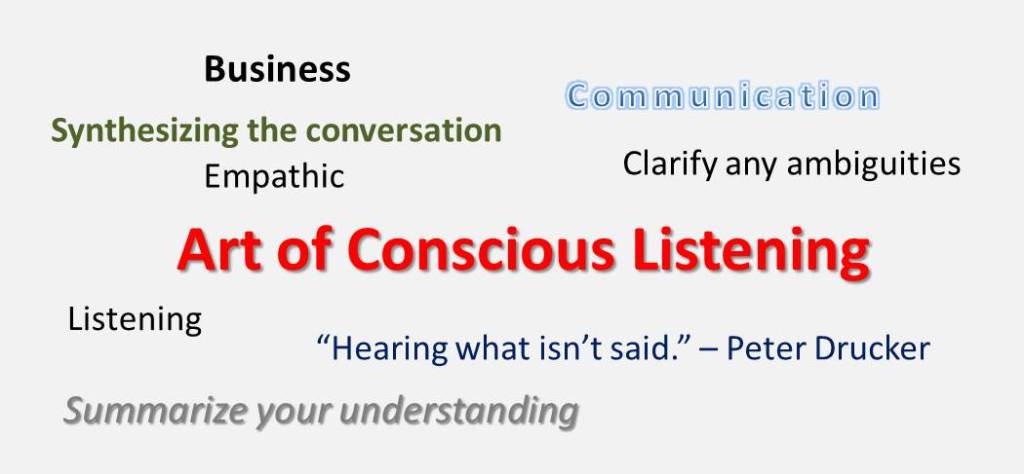 Listening skills are critical in business, as in life, yet are rarely taught. And it seems that with all of today’s digital distractions, we may be getting worse than ever at listening to what others have to say. Case in point: studies indicate that we hear only about 25% of what is said to us and retain even less – 10% on average.[i][ii] Yet as B2B marketers, the most fundamental aspect of our role is to understand the perspectives of others in order to create messages that resonate with and engage our target audiences in a unique and insightful manner. So, whether you’re looking to conduct more effective interviews, build better rapport with customers and colleagues, or work more productively with team members, through conscious listening you can engage in more meaningful and valuable business conversations by following these tips:
Listening skills are critical in business, as in life, yet are rarely taught. And it seems that with all of today’s digital distractions, we may be getting worse than ever at listening to what others have to say. Case in point: studies indicate that we hear only about 25% of what is said to us and retain even less – 10% on average.[i][ii] Yet as B2B marketers, the most fundamental aspect of our role is to understand the perspectives of others in order to create messages that resonate with and engage our target audiences in a unique and insightful manner. So, whether you’re looking to conduct more effective interviews, build better rapport with customers and colleagues, or work more productively with team members, through conscious listening you can engage in more meaningful and valuable business conversations by following these tips:
Before a conversation: “Most people do not listen with the intent to understand; they listen with the intent to reply.” –Stephen R. Covey
- To better prepare – especially for a difficult or important conversation – empty your mind of distractions by doing a ‘brain dump’ to help clear the clutter. For example, create a list for later reference of off-topic items and issues that are nagging at and worrying you.
- To help bring clarity and focus to your conversation, make a list of key questions or points you want to discuss. Having a ready-to-hand list will also free your mind so you can properly focus on the speaker, without worry about forgetting anything you want to ask or discuss.
- Acknowledge the inherently judgmental mental models we all have and check them at the door. Be aware of how your perspective is shaped by your culture, language, beliefs, values, attitudes, expectations, and intentions – and likewise recognize that differing perspectives will be similarly shaped by different life experiences. Priming yourself to recognize these mental models will allow you to more fully grasp the complexity and nuances of issues discussed, as well as acknowledge valid but different points of view.
During a conversation: “The art of conversation lies in listening.” –Malcom Forbes
- Limit your speaking to no more than 25% of the conversation. As Mark Twain said, “If we were meant to talk more than listen, we would have two mouths and one ear.”
- Give the speaker your undivided attention. Turn off the cell phone, don’t multitask, and instead focus fully on what is being said.
- In order to remain focused on the speaker, while listening make quick notes on questions that pop up and points that might require clarification.
- Show your speaker that you appreciate, respect, and are actively listening to what they are saying by making listening sounds such as “mhm” and displaying encouraging body language, such as nodding and making eye contact.
- Likewise, take note of non-verbal cues your speaker is providing, such as facial expressions, body language, and tone of voice, which can provide enhanced understanding of the emotions and subconscious motivations at play.
- After the speaker finishes, summarize your understanding of what they’ve said to ensure you are both on the same page.
- Clarify any ambiguities and show interest in your speaker by asking thoughtful questions.
Synthesizing the conversation: “The most important thing in communication is hearing what isn’t said” –Peter Drucker
- Learn to hear what isn’t said and discern meaning from the information that is provided. Often we don’t always know what is truly motivating our choices and behaviors. Consequently, we sometimes make decisions, or statements which seem disconnected. Hearing what isn’t said and understanding what motivators might be at play, can help you gain insight that both explains their disconnect and allows you to influence the irrational behavior.

Achieving understanding – ascribing meaning to the information provided – is hard work. In order to engage in effective conscious listening, we must be aware of our own subconscious mental models through which we filter all information. It is only with this awareness of what shapes our perspective that we can truly learn to hear what the speaker is saying from their perspective. Further, we must understand that there is no such thing as ‘objective reality.’ Rather, the key is to get to a place of mutual understanding. For B2B marketers, this means understanding what shapes our target audience’s perception of reality and how our solutions can best fit their needs as they understand them. . With such keen understanding of the audience’s perspective, you can gain the necessary insight to craft the messaging your audience is naturally primed to hear.
“Wisdom is the reward you get for a lifetime of listening when you’d have preferred to talk.”
– Doug Larson
To hear what your prospective customers think and how you can leverage these insights, them, read our brief, “Using Prospect Surveys to Enable Insight Selling.”
[i] http://www.ted.com/talks/julian_treasure_5_ways_to_listen_better?language=en
[ii] http://online.wsj.com/articles/tuning-in-how-to-listen-better-1406070727
